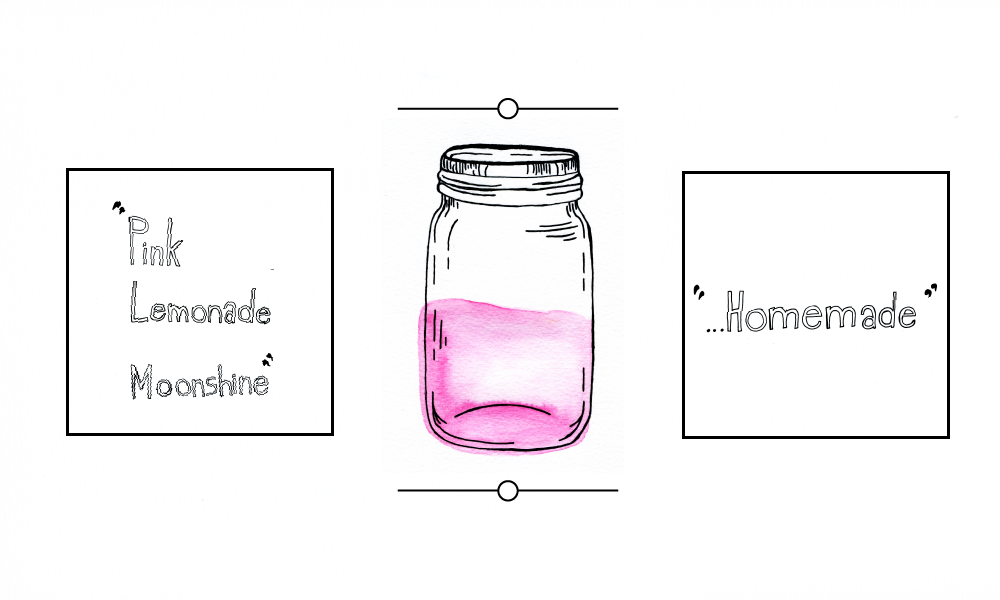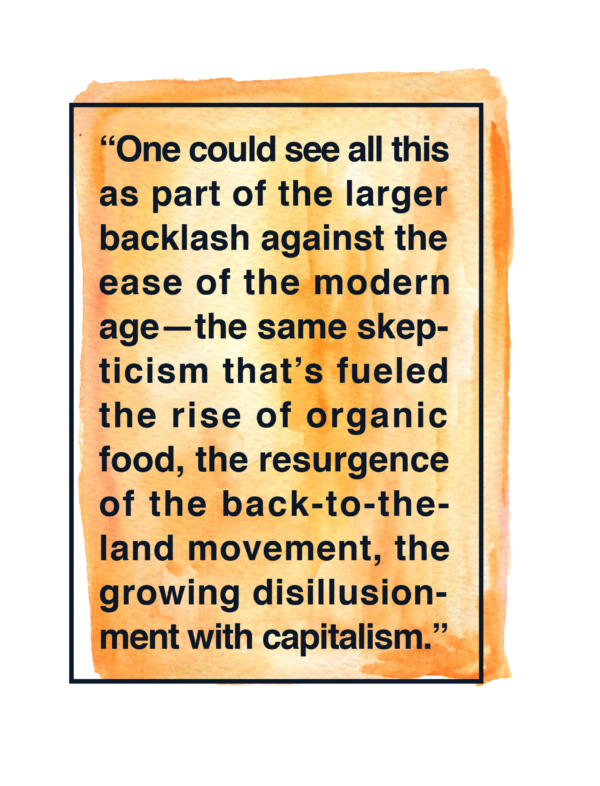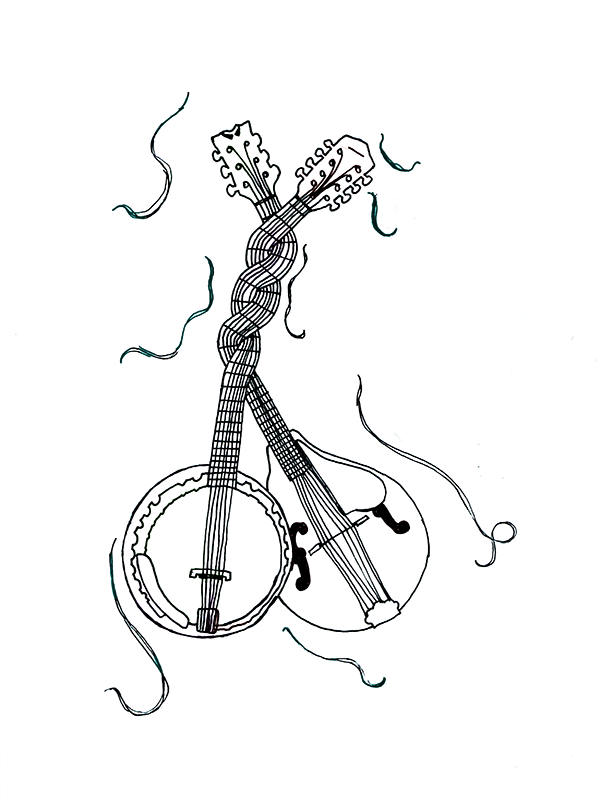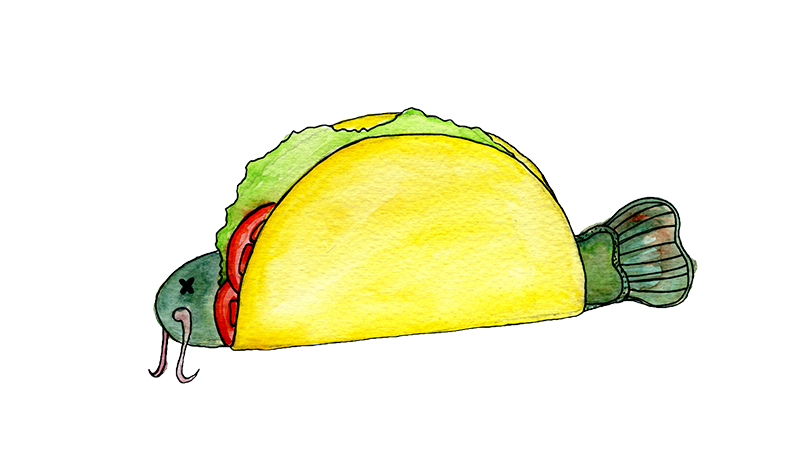At first I couldn’t tell if it was the heat or the banjos that had woken me. All through the night, music had flared up around my tent — guitars, fiddles, double basses — sometimes close, sometimes off in the distance as if in a dream. And now I thought I might be dreaming too, of banjos plunking like raindrops, their notes crisp and clear and falling around me. But the playing continued, and I opened my eyes to realize that the tent was bright and thick with humidity, and the pillow beneath my head was soaked with sweat. The temperature was unbearable. I had pitched camp the previous afternoon without thinking to look for shade, and now, in the glare of the morning sun, my tent had transformed into a sauna. Cursing and wiping my face with a shirt, I fumbled with the flap and lurched outside.
The field was packed. Twice as many tents had appeared since I’d gone to sleep, stretching down the hill out of sight. One huge canopy was pitched right next door, and the music that had woken me was coming from a small group sitting underneath, instruments in hand. One of the women glanced over, waved cheerfully, and called out, “Morning!” before inviting me into the shade. She set down her guitar and introduced herself as Nickie. Then she held up a mason jar and asked if I’d like some moonshine. “Pink lemonade moonshine,” she clarified. “Homemade.”
I looked at my watch. It was ten a.m.
“Sure,” I said. It wasn’t like I had anywhere to be. I accepted the cool jar, took a sip, and choked violently. I was no stranger to moonshine, but this felt like I had just swallowed a mouthful of hydrochloric acid. Nickie took the jar back gently as I wheezed and pounded at my chest. “Sorry,” she said. “This one was mostly everclear.”
So began my first morning at the 45th Annual Mount Airy Fiddlers Convention — though if it’s not clear by now, this was not a “convention” in the typical sense. There were no name tags, no keynote speakers, no catered lunches. Nor was it your standard music festival, with big stages and headlining acts. It was, rather, one of the biggest, rowdiest celebrations of old-time folk music in the nation: a massive gathering held every June in northwestern North Carolina. There were workshops, performances, and competitions. But most of the campers, themselves traditional musicians, would simply spend the weekend wandering the crowded ten-acre field, fiddle or banjo tucked underarm, and joining in spontaneously with other players. The result was a musical melee, a jam session with 4,000 participants. One attendee described it as the folk music equivalent of Burning Man.
It’s fair to say I didn’t know what I was getting into. I grew up in Virginia in the 1990s, in a touristy suburb a few hours east of the Appalachians. I knew vaguely about the old Southern folk ballads that had once carpeted the area, the work songs and spirituals that had survived for generations by word-of-mouth alone. But I assumed they were long gone. What I knew was informed by the CDs and dusty 45s my parents played around the house: croaky, nasal singing drifting past the bookshelves and antique vases on the sideboard. My parents are historians, and so their interest in an archaic music seemed only natural. I preferred Depeche Mode.
It was only later, after I moved out West for college, that I felt something drawing me back to these songs. I started listening to musicians like Dock Boggs and Elizabeth Cotten, finding the sparseness and unpolished nature of their playing oddly compelling. Although I had studied music in undergrad and played piano for ten years, these songs were different somehow: mysterious and primal in a way I couldn’t name. And when I returned to Virginia last summer for a visit and heard about the Mount Airy festival, I was taken aback. There were still people out there singing centuries-old folk songs? Who? It was five hours to Mount Airy from my hometown. I decided to drive south and find out.
Mount Airy is the only city in Surry County, which borders the Virginia line about 80 miles east of Tennessee. This part of North Carolina is hill country, hills that don’t rise out of the earth so much as swell regally, and it’s scattered with tiny towns with strikingly lyrical, sonorous names: Lowgap, Round Peak, White Plains, Devotion. The back roads wind past big red barns painted top to bottom with American flags and weathered convenience stores with decrepit signs advertising Dr. Pepper. I spent the drive entertaining fantasies of sitting under a tree with a grizzled banjo player, taking swigs from a bottle of whiskey and listening to stories of the olden days.
Suffice to say I was greeted with an entirely different sight when I turned into the Veterans Memorial Park at the edge of town in early June 2016. The field, which is owned by the American Legion and easily identified by the 50-ton tank parked nonchalantly at its entrance, had been transformed into a city of tents, campers, and RVs. Some were packed so tightly together it was hard to tell where one site ended and the next began. There were instrumentalists everywhere. They reclined in camp chairs, stood in circles, perched on the backs of pickup trucks. Music saturated the humid air.
I found an unclaimed spot on a rise overlooking the field, pitched my tent, and walked down towards the crowd. I was suddenly consumed with anxiety. Many people were clearly regulars. I had been given a windshield sticker when I arrived, a blue diamond with a big 45 in the center, and dozens of cars were covered with stickers from years past: 44, 43, 42, 41. Others sported little music jokes (“without music the world would B♭”), or the logo of The Old-Time Herald. Meanwhile, I was the only person in sight without an instrument. I didn’t know a soul. I didn’t really know this music. I felt like an imposter: a tourist in a foreign country who had spent a few days studying the phrasebook and shown up expecting to blend in with the locals. Now I felt that to merely open my mouth would expose me as an outsider.
But at the same time, I was mesmerized. This was no dead music. Other young people swirled past me, long-haired and tattooed, banjo cases in hand. Friends embraced and sat down to play. I wasn’t sure what I was witnessing. The 2016 election had turned the American landscape into a minefield. My own friendships were fraught, whole conversations spent shouting past each other; I now checked social media with a pronounced sense of dread. And yet at a time when the country was becoming increasingly divided and individualistic, I had stumbled into a vibrant, thriving community — in the unlikeliest of places.
•
Old-time, hillbilly, mountain music. There are many names for this tradition, and each one means something different depending who you ask. But they all, in essence, describe the same thing: the thousands of traditional songs played by those we today might call the rural working class in the Appalachians and rural southeastern United States. Born of a fusion of English folk tunes and African rhythms and instruments, these songs are among the oldest American oral traditions, dating back to at least the early 1700s. Like the stories of Native Americans or the ancient Greeks, these songs were rarely recorded and rarely written down. They were personal and non-commercial, sung by farmers, miners, housewives, lumberjacks — not professional musicians, in other words. This was music of the common folk. Folk music, if you will.
We now have iPhones and Spotify to pass the time, Beyoncé and Bon Iver. But the impoverished families in the hills and hollers of rural Appalachia in the 18th and 19th centuries had no such option. So they made their own music: songs to sing while working in the fields or hanging laundry out to dry, to play while sitting in the living room at night. The songs were played on the banjo, or the fiddle, or the mandolin. If none of those were available, one might blow across a jug, or pick up a kazoo, or simply sing a cappella. When the time came, a father would teach his favorite songs to his child, or a neighbor would share a tune with a neighbor, and the music would propagate and carry on down the years.
You hear the term “homemade” a lot in relation to old-time — the great musicologist Alan Lomax fondly referred to the songs as “homemade hand-me-downs in words and music” — and it fits. Instruments were culled together from whatever material was lying around: spare lumber, tin cans, cake boxes. The strings on a banjo might come from horsehair; the heads from the skins of “cats, possums, raccoons, sheep, snakes, and other assorted creatures.”
And that’s not even mentioning the music, which just sounds rural: rough and rickety as a wooden cart. The songs are wild, propulsive, and often beautiful. But they’re frequently infused with loneliness and the hard details of mountain life, with narratives immortalizing local news, gossip, and politics. The lyrics report murders and suicides, courtships and marriages, bloody feuds and union strikes. There are songs about pegging shoes, hoeing crops, and building houses. “Last year was a very fine year for cotton, corn, and tomatoes,” one informs us. Some are kids’ songs, giddily nonsensical, full of talking bluebirds and old men combing their hair with wagon wheels. Others, somber and stern, tremble before the might of God. “O Death,” Dock Boggs sang on his most famous recording. “Can’t you spare me over ’til another year?”
Like many oral traditions, old-time has been on the retreat for much of the last century, as the rise of radio, television, and the digital age have replaced the need to remember and play music for entertainment. Outside influence, too, began seeping into the once isolated homesteads, pushing the decidedly old-fashioned music further out of step with the changing culture. Dylan went electric. Families bought their first TVs. Then came the politics of shame, as films like Deliverance single-handedly recast the banjo — and Appalachia in general — as the provenance of rotten-toothed, psychotic hillbillies. The damage was quiet but swift; a silence descending across the mountains. For a tradition reliant on continual oral transmission, the loss of just one generation can be devastating, and in the 1960s, a surge of alarmed musicians and researchers began tracking down and recording the old songs. Those efforts were largely responsible for saving the genre from extinction. But staving off extinction and turning back the clock are not the same thing, and there remains a perpetual tension in the old-time movement: part revival, part survival, a sword of Damocles suspended overhead.
•
Once I had recovered from the moonshine, I dragged over a camp chair and sat down with my neighbors. There were two others besides Nickie, both holding banjos, who introduced themselves as Joseph and Andrea. Like me, this was their first time at Mount Airy. And they were all young. Andrea and Joseph were both in their early 20s, and while Nickie was in her early 40s, she had the infectious energy of someone half her age. Still, they were consummate musicians. Joseph had taken lessons with the great banjo player Béla Fleck. Andrea played daily back home in Knoxville, Tennessee: sometimes busking on the street, sometimes with an informal group of older musicians. I mentioned my surprise at how young everyone at Mount Airy seemed to be, and Andrea nodded in relief. “There aren’t a lot of young people playing old-time in Knoxville,” she said, “and I’m a little tired of hearing about everyone’s hip replacements between each song.” We laughed. “You think I’m joking!” she cried. “They compete with each other! ‘My body is more decrepit than yours!’”
It made sense for older people to play old-time. But, I asked, what was it about the music that attracted younger musicians? The three looked at each other, clearly at a loss. Andrea cocked her head; she had thoughtful blue eyes and a broken watch that she kept tapping and holding up to her ear. “I like traditional things,” she said at last. “There’s something rooted in this part of Appalachia.”
Joseph nodded at this and leaned forward in his chair. He had grown up, he told us, on a farm in Highland County, Virginia. He was the youngest of eight children, and the bath water was so filthy by the time it was his turn that he had to bathe out in the barn, in the horse trough. But there was something he loved about that upbringing, he said: “I remember sitting in that horse trough, looking at the mountains and making echoes.” When he was in his early teens, his family sold the farm and moved to Alabama, and Joseph felt downright ill from missing home. Then he realized the sound of the banjo could evoke memories of Virginia in a way little else could. He began playing quietly, in secret, his fingers pulling from its strings the coolness of his family’s barn, the smell of dirt, the drip of water. As soon as he was old enough, he left Alabama and returned home.
This type of story is a documented phenomenon throughout Appalachia. Writing in The New Yorker, Larissa MacFarquhar comments on the loyalty that West Virginians demonstrate towards their state and their community. “Many people talk about a connection to the ground itself,” she observes. “The densely wooded hills are crushed so close together there’s barely room for a road between them.” This “confining closeness” — not to mention the isolation inherent in small, mountain-bound towns — forges a powerful, tangible bond between people and the land they inhabit. North Carolinian Jeremy B. Jones has dubbed this sensation “the Pull.” “As if by a massive magnet hidden beneath the soil,” he muses in his memoir Bearwallow, “people were affixed to these mountains. Even those who tried to leave, to explore or plant roots elsewhere, were pulled back eventually.”
This, it seems, is unique. We are increasingly a people on the move, and on the move towards urbanization: According to a benchmark 2009 U.N. Habitat report, three million people worldwide move to a city every week. And yet there’s something about the mountains of Appalachia that trumps that urge. The population of Surry County — 73,000 — has remained fairly stable, rising less than three and a half percent since the year 2000, and other counties in the region have only grown. Even in our little group, the Pull was plainly evident. Nickie told us that she had spent the last 17 years in Lincoln, Nebraska, where her parents now lived, and had only returned to her hometown of Eagle Rock, Virginia, in the last year. The sensation, she said, had been like spending two decades away from a part of herself. “My soul doesn’t hurt anymore,” she said. I, too, confessed that although I had left Virginia eight years earlier for the West Coast, I felt myself constantly drawn back east. That I had no desire to return home was beside the point; my connection to Virginia was deeper, as if imprinted on my DNA itself. “What about you?” I asked Andrea. “Think you’ll ever leave Tennessee?” She shook her head without hesitation.
One could see all this as part of the larger backlash against the ease of the modern age — the same skepticism that’s fueled the rise of organic food, the resurgence of the back-to-the-land movement, the growing disillusionment with capitalism. But I couldn’t help but wonder if there was something else at work, a larger question of how we define “home.” Cities are manufactured environments, their populations and neighborhoods frenetic and ever-changing. As the joke goes, no one from New York is actually from New York. Yet home, by its very definition, is a fixed point, a refuge in its sameness. It is rocks and trees and soil, lineage and tradition. It is slow.
For Appalachians, whose families have often inhabited the same plot of land for generations, the ground assumes its own character. It is as crucial to personal identity as family. And nowhere is this more evident than in the music: from stories like Joseph’s, to lyrics of the lonesome traveler, aching to return not to a lover, but to the place itself. “O Shenandoah, I long to see you and hear your rolling river” . . . Or the song that Andrea and Joseph were beginning to play, Andrea’s low, clear voice weaving beneath their banjos: “My home’s across the Blue Ridge Mountains . . . and I never expect to see you anymore.” It made me wonder: When was the last time I had thought of a physical place so intimately? A piece of geography that had molded and shaped me as much as any person? So many of us are moving, moving, moving, searching for a place that felt right, an identity that fit. And yet Andrea and Joseph and Nickie had found it, right in the place they had started.
•
At first, the Fiddlers Convention appeared to be a haphazard, randomly constructed affair. But as I explored throughout the weekend, I discovered that the festival followed a discernible, if unwritten, map. The rise where I had pitched camp had been claimed by the younger generation, some of whom had come from as far away as Pennsylvania and Arizona. Their campsites were staggeringly elaborate affairs, like the courts of medieval kings, and had kitchens stuffed with collapsible iron stoves, pepper grinders, and bottles of balsamic vinegar. Following the path downhill took me into a nest of RVs that one attendee deemed “Bluegrassland.” The folks here seemed older, more local, more conservative; one van I passed was slathered with incendiary anti-abortion stickers. There was also a stage for competitions (a converted semi-trailer, its side removed), a barn-like building that turned out to be a grandstand, and, bizarrely, an empty petting zoo. (I later learned that the park doubles as the county fairground.) And out towards the entrance lay a final clump of tents, inhabited by musicians who preferred to stay out of the late-night playing and partying that had woken me.
Every site raged with music. Fiddles reeled like runaway freight trains, wild and delirious. Banjos and mandolins wove playful melodies around each other. A dozen men in cowboy hats stood strumming guitars and blending their voices together in magnificent harmony. I took to wandering slowly and aimlessly through the park, an ocean of sound, the music from one camp receding only to be replaced by the next.
Much in the same way that Appalachians find themselves drawn back to the place they were born, Mount Airy attendees also return year after year — down to the same spot, the same blade of grass. “We have camped right here for 25 years,” the banjo player Marsha Todd told me, gesturing to her family’s Bullet RV. “Everybody knows: Slate Mountain Ramblers [her family’s band], before you get to the stage, on the right. If it’s the Dog Hill Draggers, they’re back behind the stage. You know where everybody’s at. It’s like, you come home, you have your own bedroom.”
I had first come across Marsha on a documentary called Banjo Tales, which highlighted a selection of the most talented young players across the South. Marsha, who had lived her whole life in Surry County and had big, round eyes that reminded me of a startled cat, certainly fit the bill. She started playing when she was four: first the cello, then the string bass, and finally the banjo. Her childhood birthday parties were massive square dances of 150 people or more: frenzied storms of fiddle and banjo, raucous, stomping events. Now, at only 34, she had garnered a reputation as one of the finest dancers and banjo players in Surry County. Three whole walls in her basement were covered, top to bottom and not an inch between, with ribbons she’d won performing at festivals and contests. Later that weekend, I would see her play in the Mount Airy competition: her hand darting like a woodthrush up and down the fretboard, fingers swift and nimble as a concert pianist’s. She would take home the top prize.
I was curious to learn about the music from someone who had grown up with it. But Marsha deflected — not out of rudeness, but because it just wasn’t something she thought about. Like great athletes whose genius lies in the sport, and not in the post-game interview, Marsha seemed uninterested in dissecting what the music meant to her. “It’s like eatin’ for me, breathin’,” she explained. “How do you not do something you’ve done for 34 years?”
But Marsha comes from a musical family, and I happened to walk in on her father, Richard Bowman, giving a fiddle workshop in the bandstand on Saturday afternoon. It was suffocating inside, the air thick with dried sweat and suntan lotion, and I was sucking on ice to try and cool down. Richard, a slim, white-bearded man wearing a red Carquest Auto Parts cap, was sitting in a circle of chairs with a group of 20-odd musicians. “I’ve had 300 fiddles,” he was saying when I entered. “I have rescued a bunch of them things over the years. They get dilapidated, tore up, they get out of tune . . . so I buy ’em and fix ’em and cram ’em under the bed. Sold most of ’em off except for 20 or so.”
Richard was as much an institution at Mount Airy as his daughter. He would talk for a while and then pause and lift his fiddle and play a tune — casually, like the thought had just occurred to him, yet clean and precise as a Vivaldi concerto. When he stopped, a respectful silence would descend. Then somebody would ask a question, like “Where did you learn to play that?” and Richard would start talking again, his stories spilling out in a rich, fluid Southern Appalachian accent.
“I learned all my tunes from warm hands,” he said. He reached under his seat and produced a typed, five-page list of the tunes he knew. “There’s probably stories about all them tunes that I can, if I had the time to, tell, about where I learned ’em and who I learned ’em from.” He picked one at random, “Ragtime Annie,” and told a long, rambling tale about a jam session at a local fiddler’s house; how, halfway through, the fiddler’s son came stumbling in from the back room, drunk as a skunk and naked as a jaybird, wearing only a bedsheet he had thrown over his shoulder. The entire circle of musicians dissolved into laughter.
Learning from others reinforced a fundamental tenet of old-time: There’s no wrong way to play it. Back in the old days, Richard said, communities were so isolated that songs tended to take on lives of their own; you could hear the same tune played ten different ways in ten different counties. Sometimes the melody was altered; sometimes the rhythm or the lyrics changed. Sometimes even the style of playing was unique. “You could have a dozen fiddlers in a 30-mile radius and no two play the same,” Richard explained. Each county was, in a sense, its own autonomous unit, its music as clear a dividing line as a fence. One could even think of the Mount Airy festival as a kind of microcosm, each campsite home to its own unique musical identity.
As the land shaped the people of Appalachia, so too it shaped the music they played. Until the mid-20th century, there were few recordings to listen to. This meant that there were few influential old-time figures to imitate, no Duke Ellingtons or Louis Armstrongs. This allowed people to play as they wanted, unbound from arbitrary notions of good or bad. Furthermore, it meant that they really only had one option available if they wanted to learn new music. “There are stories of people walking ten miles to learn a tune,” the banjo player Riley Baugus told me later that weekend. “‘I heard somebody say Old Man So-and-So was a good fiddle player, so I’m gonna go walk over here to his house and see if he’ll show it to me.’ And if you were lucky, and didn’t get shot, you became his friend. But even then the lesson would not be a lesson, it would be playing the tune to get it in your head.” Then you would take it home, your memory perhaps half-formed, and teach it to others. In this way, the songs evolved.
This combination — the tradition of learning music from “warm hands,” the lack of written or recorded references, and the simultaneous blossoming of countless styles of playing — has resulted in a singular level of musical diversity. Classical musicians, for example, are generally expected to play a piece of music as closely to its written notation as possible. Even jazz, the most improvisational of genres, developed in an urban setting filled with mentors and other performers, and values a high level of technical precision. By contrast, the hundreds of different styles and interpretations in old-time grew largely in isolation, influences few and far between. These unique voices are key to the music’s identity, and attempts to mimic are frowned upon. There are no “definitive” versions.
Riley, who was featured on the same Banjo Tales documentary as Marsha Todd, explained this to me. “There are two things,” he said. “Authenticity and exactness. Now if you change the way you play one phrase, or if your brain decides to change the rhythm of this little bit . . . have you destroyed the authenticity by not playing it exactly? Or are you allowing the music to live and breathe and progress in its natural state? You can’t do anything but play the way you play. And I think you can hinder the music by trying to play it too much like the person you learned it from, or the way it was on that record in 1927. It’s like trying to keep a bug in a jar with a lid on it. Eventually it runs out of air and dies.”
•
When I stepped outside after Richard’s workshop, the temperature had plummeted and the sky had turned black from a giant thunderhead. I made it back to my tent just as the first drops began to fall. The storm was vicious: rain swept sideways, lightning slashed above the trees. People huddled beneath their canopies, seizing onto the frills to keep them from blowing away. I lay on my sleeping bag, listening to the thunder knocking overhead, the deluge beating against the top of the tent. Far away, a harmonica blew a few notes. Closer by, I heard a woman start singing as she waited out the storm, her voice cracking at the end of each line:
When I first came to this country in 1849,
I saw many fair lovers but I never saw mine . . .
When she came to the end of the verse she paused and then started over again, and I dozed off to the sound of her voice, stark and low and lonely against the storm.
When I woke, the rain had passed, night had fallen, and the party had started. I emerged from my tent to discover that the stadium lights around the field had switched on, flooding the tent city below with brightness. Back-lit figures swirled past me, cloaked in clouds of cigarette smoke. But what had woken me was the cacophonous, freewheeling sound filling the air, the sound of 4,000 musicians playing at once. Fiddles clambered upwards like vines on a tree; banjos, mandolins, and dulcimers tumbled eagerly over each other. Double basses plunked beneath the din. It was like the chaos of an orchestra tuning, only with more cheering. A guitar strummed furiously from the open sliding doors of an SUV; music poured down the hill; somebody sang, “Who’s gonna miss me when I’m gone, when I’m gone?” The music was bright and urgent, beaming out a boundless energy, and the stars above were silent and still.
I wandered. Musicians in the ticket booth; musicians in the petting zoo; musicians beneath white canopies, stretched wide above them in the trees like giant birds coming in to roost. Musicians gathered in circles, a small flickering candle at the center. Discarded banjo strings littered the ground. Music exploded joyously from every tent and RV and open space. In the dark I could make out nobody clearly, only shadowed forms conjuring music like spells from the air. The community I had noticed on the very first night was out in force. All around me groups were forming with ease, the music providing a shortcut past the pressure of small talk and forced introductions. But with no way to join in, I couldn’t help but feel that same loneliness: the gnawing sense that I was only an observer.
Trying to distract myself, I joined a crowd clustered at the edge of one of the tents. They were watching a group play: an older fiddler, his hair slicked back like an aging rock star; a young banjo player, his fingers dancing across the strings; a teenage girl hammering a guitar. They were sitting in one of the sprawling setups just a few sites away from me, and I sat down at its picnic table, across from a long-haired guy eating a fried catfish taco. His name was Steve, and it turned out that these were his digs. He had been coming to the festival since the mid-1990s, driving down from upstate New York, and was camping with a friend who had come up from Louisiana. I raised my eyebrows in surprise. “How’d you meet?”
Steve pointed to the picnic table. “Here,” he said. “At Mount Airy. Years ago.”
“Is that . . . normal?” I asked. “Do you have closer friendships here than in real life?”
“Oh, definitely,” he said, nodding vigorously. He took a bite of his taco, then gestured to the musicians behind us. “I mean, just look.”
It wasn’t hard to see what he meant. The five musicians were sitting in a tight circle, heads bowed in focus, so close together that the fiddler’s bow was almost stabbing the guitarist in the head. It was entirely possible they hadn’t known each other longer than an hour. Yet there was a palpable intimacy between them: a literal closeness.
“You spend 50 hours together playing tunes,” Steve was saying. “That’s some intense bonding. There’s a kinship here that you have to work for —” He motioned past the field to the town, the county, the world. “— out there.” He paused. “And all kinds of people. There could be some Republican who’s all about his religion and his —” (he fished around for a minute) “— his coal mining, and you can just sit down and play some tunes together, and none of that matters.”
This was no small deal. Three months earlier, the North Carolina legislature had passed HB2, the so-called “bathroom bill,” an anti-LGBT law that forced transgender people to use the bathroom that aligned with the gender assigned to them at birth. Arriving in the middle of the already-contentious 2016 election, HB2 sparked a vehement backlash. PayPal announced they were scrapping plans to expand into Charlotte. The NBA relocated their 2017 All-Star Game to New Orleans. And the state Attorney General (and future governor) refused to defend the bill in court.
Public rhetoric, meanwhile, soared to new levels of ugliness. One UNC professor authored a report that, in light of the state’s extensive civil rights offenses, ranked North Carolina’s democracy on par with Cuba’s. The response was vehement, he told GQ. “People were saying I should be kicked out of the state, I shouldn’t be teaching our children, ‘Why are you dressing up like a woman to attack my daughter?’” Politics have always been a touchy subject for Americans. But in the wake of HB2, the mere hint of any political disagreement was enough to send a conversation into a full-fledged screaming match.
Strangely, Mount Airy seemed to neutralize political animosity. Over the weekend, I had met atheists and Baptists, Bernie bros and Donald Trump supporters alike. I had seen a car slathered with spoiling-for-a-fight anti-abortion bumper stickers (“If it’s not a baby, then you’re not pregnant”). Someone else had printed signs satirically segregating the portapotties into “Bluegrass Bathrooms,” “Old-Time Bathrooms,” and “Banjo-Neutral Bathrooms,” with a note at the bottom calling attention to the “massive discrimination” faced by transgender North Carolinians. The proximity of all these different beliefs seemed like a firestorm waiting to happen. And yet I hadn’t witnessed a single fight or argument all weekend.
Steve had a theory about this. As the musicians behind him finished one tune and launched into another, he told me about the book Social Intelligence, by the psychologist Daniel Goleman. The book examines the way people perceive and act upon imperceptible social cues. Early on, Goleman relates a startling anecdote. Music, he writes, is such a powerful force that when two musicians play together, it’s not just their feet tapping or shoulders swaying that match up. If you were to hook up brain monitors while they were performing, “the rhythms of neuronal firing in their right hemispheres [would be] extraordinarily close. The synchrony of these zones is far greater across brains . . . than for the left and right hemispheres within each brain.” Put another way: when one person plays music with another, the right side of their brain has more in common in that moment with the other person’s than it does with the other half of their own brain.
This is true across all different types of music. But I felt there was something about old-time that made it particularly receptive. Part of this was the fact that, as in the old days, few people at Mount Airy actually worked as musicians. Steve owned a cidery. Marsha Todd worked for an electrical contractor. Riley Baugus had been a blacksmith and welder; Nickie had served in the Navy. Andrea had the most colorful resume: Her jobs had included counting blades of grass for a grad student at the University of Tennessee and squashing bugs by hand on an organic farm. (“No pesticides,” she explained, a little bitterly.) Music was something they did to relax.
The musicians at Mount Airy had thus been exposed to a remarkable cross-section of the population, especially as the music expanded beyond its original borders. And while one could make the same observation about any genre of music — classical, jazz, or pop — those genres tend to be measured by the accomplishments of individuals. Old-time, on the other hand, based as it is in Appalachian heritage and geography, emphasizes learning the music from and with a community of people, free from the tyranny of recordings or even private tutors. This, naturally, leads to encountering people with different backgrounds and beliefs. It leads to meeting people who play differently than you. And above all, it fosters an atmosphere of acceptance. Without the demands of perfection faced by, say, a violinist in the Berlin Philharmonic, attendees can set aside their ego and play — and talk — without fear of critique. Placed on an even keel and united by a common identity, community takes precedence over the individual.
The Mount Airy festival, it should be mentioned, is hardly a utopia. There was, for instance, an unavoidable lack of racial diversity: the field, from start to finish, was a sea of white. This startled me at first. Old-time literally would not exist without the contributions of black musicians. The banjo is an African instrument; innumerable old-time tunes have their roots in the blues or in Negro spirituals; and many of the great old-time musicians, from John Dee Holeman to Rhiannon Giddens, are black. Still, as the music historian Bill Malone has pointed out, old-time’s heritage is fraught for black Americans in a way it’s not for whites. Instruments like the fiddle and banjo are irrevocably linked with slavery. Many of these areas, too, have been predominantly white since Emancipation, as blacks fled the rural South for cities and didn’t look back. That this musical divide has lingered through the years is inevitable. Black Americans have since developed a rich musical culture all their own, and old-time is not exactly the type of music that lets you forget the past.
So there is work to be done. But there are reasons to be optimistic. For one, the depth of community at Mount Airy is unique in America. According to the Geert Hofstede model, which compares elements like masculinity, pragmatism, and power distribution around the globe, America ranks as one of the most individualistic countries in the world — a staggering 91/100. While individualism can lead to innovation and independent thought, it can also result in dangerous levels of isolation. One study found that, compared to collectivist countries like China (individualism score: 20/100) or Panama (11/100), members of individualistic societies often struggle to understand different perspectives and points of view — a statement that couldn’t help but remind me of the widening abyss between liberals and conservatives.
Modern communities tend to be linked by ideologies, rather than in spite of them, formed within the confines of schools or churches. But the Mount Airy Fiddlers Convention provides valuable proof that, in an age where we view people with opposing views as stupid or even immoral, the opposite is still possible. If anything, the resulting friendships seem stronger, more durable. “There’s many people we feel like we know really well,” one musician would tell me later. “We’d love to have them stay with us for a visit, invite them into our home, and we might have only interacted with them twice a year, for 20 years. That’s not a lot.”
But it’s enough. Old-time has provided its players with a common identity they can recognize: a way for empathy and respect to grow. I cannot say for sure what happened when the festival ended and the musicians dispersed back to their lives. But there on that hillside in bitterly partisan North Carolina, I felt, for the first time in a long time, something resembling hope.
I spent the rest of the evening wandering through the floodlit park. The warm air was like silk against my skin; voices shouted, voices sang, music swirled like smoke around me. As I began to walk back up the hill, I heard my name: Nickie, Joseph, and Andrea, waving from inside a darkened gazebo. They stood in a small mob with a few other musicians. As I stepped inside to join them, one of the fiddlers started playing, somebody else started dancing, and the whole place burst into life: Andrea and Joseph’s banjos plucking, the fiddle melodies ducking around each other flirtatiously, Nickie’s guitar strumming frenetically beneath it all.
I sat down on a folding chair to watch, and as I did so, I knocked something over with my foot. It was a plastic jug: an empty gallon water bottle skittering across the floor. I reached down to turn it upright, and as I did, I had a thought. I turned the jug upside down and tucked it between my knees. I gave it a few experimental taps with my fingers. Then I closed my eyes, felt the music pulsing around me, and began drumming on the upturned jug. The plastic sent out a deep plonking groove beneath the other instruments. Somebody let out a whoop. My fingers danced across the bottle, rolls and syncopated taps. And in that moment, I felt what everyone had been telling me, that unreal, instantaneous bond between me and the rest of the group. I would learn their names later, I knew. I would hear their stories. But for now, we shared something deeper, something quiet and nameless. And so we continued to play late into the night, until there was nothing left in the world but each other and the music. •
All images created by Emily Anderson.











